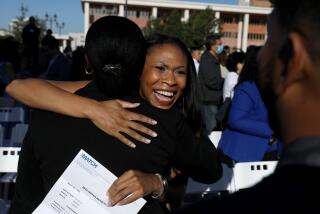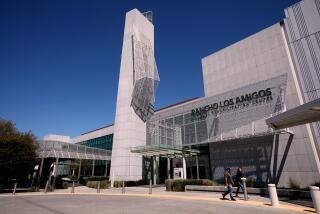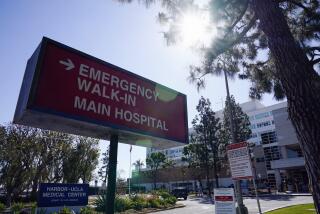Easygoing Doctors Were Suited to a Difficult Job : Medicine: Wounded physicians took on the often unpleasant task of deciding which patients would be treated urgently, who would wait and who would be turned away.
When County-USC Medical Center instituted a new screening system for its emergency room three years ago, Dr. Richard May was one of the first physicians to volunteer for the often unpleasant assignment. His task--to decide which of the hundreds of sick people who walked through the hospital’s door each day got immediate care, which could wait and which could be safely turned away.
Two weeks into the job, he voiced his frustration to a Times reporter in a brief interview--between patients--at one of the world’s largest medical facilities.
“The type of people who come to (County-USC) are the people who have been turned away from every other hospital and now here I sit turning them away again,” he said. “It’s not what I was brought up to do in medical school.”
Nevertheless, May stayed in the job longer than anyone else. He and two other physicians were doing it Monday when a disgruntled patient shot all three.
May, 47, a father of four, was the most seriously hurt and underwent surgery for wounds in the torso and head. He was listed in guarded condition Tuesday. The other two men-Dr. Glen Roger and Dr. Paul Kazubowski--were upgraded from critical to serious and reportedly had been moved to the nearby USC University Hospital.
Like May, Roger and Kazubowski were described as dedicated physicians who were gifted with the easygoing personalities considered a requisite for emergency room screening work.
“You have to have high tolerance for frustration; otherwise you wouldn’t be able to keep those jobs,” said Dr. Gerald Looney, who once worked in the County-USC emergency room and who knows the three wounded men.
The hospital refused to release information on any of the three physicians, and their families have not made themselves available for interviews. But some details of their lives could be gleaned from previous interviews and from colleagues and friends.
Very little could be learned about Kazubowski’s career. Looney said only that Kazubowski, 44, came to the United States from Poland in the 1950s or ‘60s and moonlighted at an urgent care clinic in Redondo Beach. He has been at County-USC for four years. Friends said his wife is a pediatrician and his father is a well-known cardiologist in Poland.
Roger, the father of a 4-month-old son, did not begin medical school until he was in his 30s, according to Russ Manzatt, a Topanga screenwriter who is a close friend.
His medical career is fueled by a deep idealism, Manzatt said.
“His dream is to one day practice medicine in Central America for humanitarian reasons,” he said. “He believes that poor people should have the same quality of medical care as others.”
While he was training to be a physician, said Manzatt, Roger completed a Spanish-English dictionary of medical terms he hoped would be useful to his colleagues who deal with many Spanish-speaking patients.
Yet despite his dedication, Roger, who had been at County-USC for two years, sometimes voiced weariness with his work.
“He talked about the frustrations of working in a system where the budget had to be cut,” Manzatt said. “He said it was very difficult and he felt bad that the care wasn’t better.”
The screening system that the hospital began in 1990 was instituted after county supervisors cut $7.6 million from the health services budget to cope with cutbacks in county funding ordered by the state Legislature.
May, who also serves as a clinical assistant professor of medicine at USC’s School of Medicine, has been a physician for 21 years, supervising medical students working in the emergency rooms and training residents assigned to his department.
He was second in command in the emergency room where he was shot. One of the hospital’s three emergency rooms, it reserved for patients with the least serious illnesses and for what one physician described as the “worried well people.”
While May accepted the responsibility for identifying those most in need of care, he added some compassionate criteria of his own. He was known to not turn away the frail elderly, no matter how minor their complaint seemed.
“Some of them are so confused, I know they will never get to a health center if we don’t take care of them here,” he said in the Times interview in 1991.
His thorough understanding of the county system--knowing, for example, that patients with milder symptoms were placed on a two-month waiting list--also led May to allow in some patients he feared would otherwise fall through the cracks.
“Many have mental disorders,” May explained. “They can’t follow even simple directions. Ten percent of them can’t read. These are not the kind of patients you find at a private hospital.”
Time staff writer Irene Wielawski contributed to this story.
More to Read
Sign up for Essential California
The most important California stories and recommendations in your inbox every morning.
You may occasionally receive promotional content from the Los Angeles Times.










